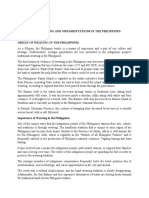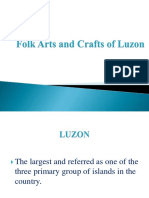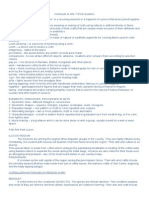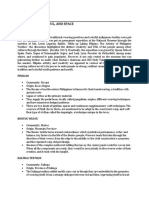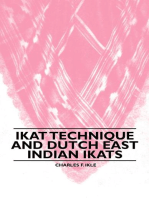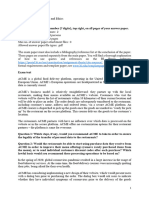0 ratings0% found this document useful (0 votes)
127 viewsSubmitted To: Mrs. Rose Marie Laurente Submitted By: Roces Boquiren
Submitted To: Mrs. Rose Marie Laurente Submitted By: Roces Boquiren
Uploaded by
Princess Joy CubangbangThe document discusses Philippine textiles and weaving traditions from several different ethnic groups and regions. It describes the materials, looms, techniques, designs, and cultural significance involved in the weaving traditions of the Ilocano, Bontoc, Kalinga, Yakan, Blaan, Hiligaynon, and Maranao peoples. It also provides brief overviews of woodcarving traditions among the Ifugao, Tagbanwa, and Maranao peoples, as well as pottery traditions in Antipolo and Mia Casal's work in clay pottery and ceramics.
Copyright:
© All Rights Reserved
Available Formats
Download as PPTX, PDF, TXT or read online from Scribd
Submitted To: Mrs. Rose Marie Laurente Submitted By: Roces Boquiren
Submitted To: Mrs. Rose Marie Laurente Submitted By: Roces Boquiren
Uploaded by
Princess Joy Cubangbang0 ratings0% found this document useful (0 votes)
127 views28 pagesThe document discusses Philippine textiles and weaving traditions from several different ethnic groups and regions. It describes the materials, looms, techniques, designs, and cultural significance involved in the weaving traditions of the Ilocano, Bontoc, Kalinga, Yakan, Blaan, Hiligaynon, and Maranao peoples. It also provides brief overviews of woodcarving traditions among the Ifugao, Tagbanwa, and Maranao peoples, as well as pottery traditions in Antipolo and Mia Casal's work in clay pottery and ceramics.
Original Description:
jk;9['op\
Original Title
pppppppttttt
Copyright
© © All Rights Reserved
Available Formats
PPTX, PDF, TXT or read online from Scribd
Share this document
Did you find this document useful?
Is this content inappropriate?
The document discusses Philippine textiles and weaving traditions from several different ethnic groups and regions. It describes the materials, looms, techniques, designs, and cultural significance involved in the weaving traditions of the Ilocano, Bontoc, Kalinga, Yakan, Blaan, Hiligaynon, and Maranao peoples. It also provides brief overviews of woodcarving traditions among the Ifugao, Tagbanwa, and Maranao peoples, as well as pottery traditions in Antipolo and Mia Casal's work in clay pottery and ceramics.
Copyright:
© All Rights Reserved
Available Formats
Download as PPTX, PDF, TXT or read online from Scribd
Download as pptx, pdf, or txt
0 ratings0% found this document useful (0 votes)
127 views28 pagesSubmitted To: Mrs. Rose Marie Laurente Submitted By: Roces Boquiren
Submitted To: Mrs. Rose Marie Laurente Submitted By: Roces Boquiren
Uploaded by
Princess Joy CubangbangThe document discusses Philippine textiles and weaving traditions from several different ethnic groups and regions. It describes the materials, looms, techniques, designs, and cultural significance involved in the weaving traditions of the Ilocano, Bontoc, Kalinga, Yakan, Blaan, Hiligaynon, and Maranao peoples. It also provides brief overviews of woodcarving traditions among the Ifugao, Tagbanwa, and Maranao peoples, as well as pottery traditions in Antipolo and Mia Casal's work in clay pottery and ceramics.
Copyright:
© All Rights Reserved
Available Formats
Download as PPTX, PDF, TXT or read online from Scribd
Download as pptx, pdf, or txt
You are on page 1of 28
Submitted to: Mrs.
Rose Marie Laurente
Submitted by: Roces Boquiren
Region 1: Ilocos
Region 1 or the Ilocos Region is made out of four
regions and a city—Ilocos Norte, Ilocos Sur, La
Union, Pangasinan, and Dagupan City. Majority of
the population speaks Ilocano, the third largest
spoken language in the Philippines, although a
significant number also speak Pangasinense.
The region has a coast and sloping extents that are
prone to typhoon in the wet months, however
devastatingly hot during the dry season. This is the
setting of Ilocano food. It's salty because of the
closeness to the ocean. There is even a whole
territory named after asin (salt) in Pangasinan. Fish
is preserved by drying, and of course, reduced into a
paste or sauce by fermentation.
It is a state-of-the-art
convention center in the Iloilo Business
Park in Mandurriao, Iloilo City,
Philippines. Its construction was
completed in September 2015 in time
for the APEC 2015 hosting. It is built
on a 1.7-hectare of lot in the district of
Mandurriao donated by the Megaworld
Corp. The Tourism Infrastructure and
Enterprise Zone Authority allocated
P200 million for the construction of the
convention center, while another P250
million was sourced from the Priority
Development Assistance Fund of
Senator Franklin Drilon.
The Cultural Center of the
Philippines Complex is home to the
National Theater (Tanghalang
Pambansa). The theater is the centerpiece
of the 77 hectare (190 acres) arts and
culture complex located along Roxas
Boulevard in Manila. Designed by
Leandro V. Locsin, the construction of
the National Theater began in 1966 and
was completed in 1969. The theater is a
primary example of the architect's
signature style known as the floating
volume, a trait can be seen in structures
indigenous to the Philippines such as the
nipa hut. It houses three performing arts
venues, one theater for film screenings,
galleries, a museum and the center's
library and archives.
A T’boli from Lake
Sebu demonstrates how
‘t’nalak’ is
made from abaca woven
fiber. The age-old method is
widely recognized as the
‘ikat’
process
The Ilocano of northwestern
Philippines is well-known for their
handweaving, a tradition with ancient roots,
with the kapas or cotton as the main
material.
They use the pedal loom, locally
called pangablan; employ several weaving
techniques; and have numerous
designs/patterns. Different weaving
techniques include the basic plain weave,
the double-toned basket weave or binakul,
and the multi-heddle weave (binetwagan or
tinumballitan), among others. Among the
complicated one is the brocade weave or
pinilian, which uses sticks inserted on
selected warp threads to create designs that
The Bontoc textile revolves around the
idea of centeredness, which symbolises
permanence, order, and balance, key factors in the
life of the Bontoc people. Weavers demonstrate this
idea through the direction of their weave, from the
edge to the middle, to the symmetry of the cloth
construction and the repeated warp-striped design.
Bontoc weavers learn the craft through
various stages. Young Bontoc girls usually start
their training with the simplest part of the cloth, the
langkit or edging. Next, they move on to pa-ikid
(side panels), learning simple designs such as
fatawil (warp-bands) and shukyong (arrows). After
mastering this level, they move on to the most
challenging part, the sinangad-am design which
represents the Sinamaki weaving. Here, they
incorporate designs on the bands such as tinagtakho
(human figure), minatmata (diamond), and tinitiko
(zigzag). The pa-khawa (the center panel) is the
The Kalinga textiles exhibit motifs
executed as though they are embedded in the
geometry of weaving itself. It has a distinct
dialogue between red and blue, expressing itself in
broad red and blue bands of plain or twill weave,
and creating densely-composed groups of tight
stripes.
Considered the finest of
Philippine textiles, the piña fabric is
made from the fibers of the leaves of
the red Bisaya pineapple through an
arduous process. The extraction of the
fibers is a most delicate and tedious
process. The leaves provides two kinds
of fibers—the bastos or the rough fiber,
and the liniwan or the fine fiber. Using
a shard of Chinese porcelain, the
stripper removes the epidermis of the
leaf, exposing the lustrous bastos fiber.
After stripping the leaves of the rough
fibers, the stripper then run a coconut
shell on the inner layer of the leaf to
expose the liniwan.
Hablon is Hiligaynon for “something
woven,” from the root word habol, “to weave”.
It refers to the hand-woven textiles by Kiniray-a
and Hiligaynon weavers. In a Panayanon legend,
ten datus from Borneo landed on Panay Island,
established settlements and ushered in an era of
development. One of the legendary datus was
Datu Lubay, who is said to introduce the art of
weaving textiles. Weaving using the pedal loom
had been common in the provinces of Iloilo and
Antique until the arrival of mechanised weaving.
Now, there are very few places where traditional
weaving is practiced, notable of these are Miag-
ao in Iloilo and Bagtasan, Bugasong in Antique.
The hablon is usually a plain weave and has
plaid and striped designs. It is usually used for
Known for being highly-skilled, with impressive
weaving repertoires, Yakan weavers produce textile
with five different kinds of weaving, often
differentiated by technique, pattern, and function. The
bunga-sama is a supplementary weft weave, made by
using pattern sticks or heddles in the loom to produce
the pattern. The colourful striped siniluan is
characterised by warp-floating pattern. Saputangan is a
square cloth best known for its intricate and rich
design, involving optical illusion to create depth in the
patterns.
Tabih, in Blaan, refers to the native tubular skirt, and
also to the textile, while mabal means “woven” or “to weave”.
The Blaan weave the tabih using abaca fibers and the back-
strap loom. The fibers are dyed using the warp tie-dye resist
ikat technique and natural dyes from native plants. Designs
usually depict crocodiles and tiny curls. The Blaan are also
known to be accomplished embroiderers and the tabih is often
meticulously embellished with embroidery. A practice
traditionally reserved to women of high status, weaving has a
strong spiritual context in Blaan society, believed to be the gift
from Furalo, the goddess of weaving
Paete, Laguna is really proud about
their wood carvings. Paete, whose name was
derived after a chisel or paet, is a small town
on the northeastern part of Laguna. It is
famous for its sweet lanzones and its finely
made woodcraft that it was declared the
Carving Capital of the Philippines on March
15, 2005. They are simply amazing at it. From
making statues, sculptures, furniture to other
things that you can name of that can be made
of wood. As if they treat this skill as they’re
hobby or past time by creating different
images and statues out of wood. Most of the
woodcarvers in Paete are third generation
woodworking folks, this skill is still being
passed on to the next generation of
woodcarvers.
The Ifugaos of Northern
Luzon are famous for the way they
carved the mountain slopes that form
the legendary Banaue rice terraces.
They are also well known for their
mastery of wood carving. Ifugao
woodcarvings are usually of their
deities, the most famous of which are
the various interpretations of the
granary deity known as the bul-ul.
South of the Phjlippines, one finds
the Tagbanwa woodcarvers. Whereas the
Ifugaos engage in woodcarving primarily
because it is an essential part of their beliefs
and customs, the Tagbanwas of Palawan
carve for the sheer fun of it. And this is
probably why the Tagabanwa woodcarvings
stand out as one of the most exciting of
indigenous Philippine woodcarvings. These
wooden works of art are highly stylized and
reflect sophisticated aesthetics, leading one
art critic to say that they have “close
affinities to near-abstract art.”
Further down south of the Philippine
Islands, are the Maranoa Muslim
woodcarvers. Figural representations in
their craft are taboo to the Maranao
woodcarvers. Natural forms are allowed
only on the condition that they are “de-
natured.” Because of this limitation, the
Maranao woodcarvers use the okkil motif
in most of their works. The okkil motif is
rich in Sassanian character — the flowing
floral forms and S movements. The
Filipino Muslim adaptation of the okkil
has a strong indigenous character,
deriving inspiration from local plants, sea
The revised New Millennium
Editions of the “primary
continuity” Young Wizards novels
started coming out at our Ebooks
Direct store in 2011.* The project
took a while to complete, in
between other work; and as
sometimes happens in a
prolonged release situation like
this, thematically and in look-
and-feel the covers aren’t very
unified. Slowly it became obvious
that something was going to
have to be done about this.
These are "banig"
(mats) handwoven by the
people of Basey, Samar,
Philippines. Great for native
wall decor or simply as
floormat.
For Clay Avenue’s Mia
Casal, pottery is a deeply
personal journey. She not
only creates the pieces and
delivers them to clients
and patrons herself, she
also manages and teaches
classes in hopes to inspire
others with her love for
clay. Her handmade clay
pots and ceramic jewelry
are for sale at local
bazaars, and may be seen
on exhibit around the
Where most local potters draw a
clear line between function and
art, Fernando has happily
reconciled the two in her work.
Fernando’s love for pottery has
led to the creation of Antipolo
landmark, The Crescent Moon
Cafe, which is also known for
its delicious food. Her loyal
clientele for her handmade
stoneware ceramics includes
restaurants, hotels, even spas.
You might also like
- SAP Document and Reporting Compliance - Poland E-InvoicesDocument52 pagesSAP Document and Reporting Compliance - Poland E-InvoicesEuzebio RossatoNo ratings yet
- Teachers MagazineDocument32 pagesTeachers MagazineYanina Salgueiro0% (1)
- Animal Production Based On Crop ResiduesDocument169 pagesAnimal Production Based On Crop Residuesframsis2ndNo ratings yet
- Written ReportDocument7 pagesWritten ReportMICAELA MAY BENIGNONo ratings yet
- CPARDocument22 pagesCPARAngelo Christian MandarNo ratings yet
- Indigenous Creative Crafts of Visayas-RegionDocument38 pagesIndigenous Creative Crafts of Visayas-RegionMichael LacasandileNo ratings yet
- Ge - 106 Arts Appreciation Finals - ReviewerDocument6 pagesGe - 106 Arts Appreciation Finals - ReviewerJulie EsmaNo ratings yet
- Arts 7 - Lecture in Visayas Group of IslandsDocument2 pagesArts 7 - Lecture in Visayas Group of Islandsjonathan0marianoNo ratings yet
- Contemporary Philippine Arts From The Regions: Working ModuleDocument12 pagesContemporary Philippine Arts From The Regions: Working ModuleAikalyn MangubatNo ratings yet
- Arts Unit 1 Lesson 1Document28 pagesArts Unit 1 Lesson 1Haydee CarpizoNo ratings yet
- Arts 7 Day 1Document29 pagesArts 7 Day 1Yeye Lo CordovaNo ratings yet
- Arts and Crafts of Mimaropa and VisayasDocument11 pagesArts and Crafts of Mimaropa and VisayasRogerson Pena100% (1)
- Power PointDocument48 pagesPower PointMarken Iranzo EbiteNo ratings yet
- Folk Arts From Panay IslandDocument12 pagesFolk Arts From Panay IslandShiela Repe67% (3)
- ARTS&CRAFTSPPDocument34 pagesARTS&CRAFTSPPRosalinda SamongNo ratings yet
- Arts MIMAROPA HandoutsDocument27 pagesArts MIMAROPA HandoutsRex IntiaNo ratings yet
- Art App UNIT VII Dream Soul SpaceDocument23 pagesArt App UNIT VII Dream Soul SpacemelanieNo ratings yet
- GAMABADocument9 pagesGAMABAJerome PaulinoNo ratings yet
- Lesson 7Document23 pagesLesson 7Debayn OliquianoNo ratings yet
- FilipinoDocument4 pagesFilipinoangelynardeno28No ratings yet
- Arts 7 - Lesson 3Document6 pagesArts 7 - Lesson 3AQUINO MARVINNo ratings yet
- Ho Arts 7Document3 pagesHo Arts 7Michelle Anne Legaspi Bawar75% (4)
- Arts Unit 2Document21 pagesArts Unit 2Haydee CarpizoNo ratings yet
- Group 2 IccDocument37 pagesGroup 2 IccBlessed GuillermoNo ratings yet
- Art NotesDocument4 pagesArt NotesClaire MaeNo ratings yet
- Handicraft Module 6Document21 pagesHandicraft Module 6John William RosauroNo ratings yet
- ELEMENTS OF ART Lesson 1 ARTS 7 Q1Document6 pagesELEMENTS OF ART Lesson 1 ARTS 7 Q1MorMarzkieMarizNo ratings yet
- Notes On Contemporary Philippine Arts From The Regions 2nd QuarterDocument5 pagesNotes On Contemporary Philippine Arts From The Regions 2nd QuarterJerlyn Mae Sales QuiliopeNo ratings yet
- 9 UNIT VII Dreams Soul and SpaceDocument8 pages9 UNIT VII Dreams Soul and SpaceAngeline D. ArucanNo ratings yet
- Cordillera ArtsDocument18 pagesCordillera ArtsCharlene Fadrigon-OtazuNo ratings yet
- Unit I - Lesson 1 & Lesson 2Document61 pagesUnit I - Lesson 1 & Lesson 2Haydee CarpizoNo ratings yet
- Sarung Bangui, Paru-Parong Bukid MaglalatikDocument4 pagesSarung Bangui, Paru-Parong Bukid MaglalatikChedeng KumaNo ratings yet
- Arts 7 KaedyDocument10 pagesArts 7 KaedyBrianna KaedyNo ratings yet
- Page 107 113 CONTEMPORARY PHILIPPINE ARTS FROM THE REGIONDocument26 pagesPage 107 113 CONTEMPORARY PHILIPPINE ARTS FROM THE REGIONMrndyrNo ratings yet
- Arts and Crafts of LuzonDocument64 pagesArts and Crafts of LuzonJubbielyn SariaNo ratings yet
- Unit Vii. Dreams, Soul, and SpaceDocument6 pagesUnit Vii. Dreams, Soul, and SpaceKim Sarmiento100% (1)
- Arts 7 Q3 WK1 1 1Document9 pagesArts 7 Q3 WK1 1 1Rofe Shane VillarinoNo ratings yet
- As Mapeh M4Document7 pagesAs Mapeh M4Erl CasiñoNo ratings yet
- Contemporary Art On TextileDocument2 pagesContemporary Art On TextileMikahNo ratings yet
- Traditional Folk ArtsDocument35 pagesTraditional Folk ArtsClarissa ReyesNo ratings yet
- AH Learning Activity - Luzon (Brandon Perry Tajanlangit)Document2 pagesAH Learning Activity - Luzon (Brandon Perry Tajanlangit)Brandon Perry Andales TajanlangitNo ratings yet
- Mapeh 7 q1 - Week 3 (Arts)Document7 pagesMapeh 7 q1 - Week 3 (Arts)joel cagaananNo ratings yet
- 5 PHPDocument2 pages5 PHPcapt.athulNo ratings yet
- IndigenousDocument10 pagesIndigenousalmairahomie.saidNo ratings yet
- Quarter 3: Week 7 Forms of Arts From Different RegionsDocument7 pagesQuarter 3: Week 7 Forms of Arts From Different RegionsJennifer MagangoNo ratings yet
- Week 8Document3 pagesWeek 8itzmaxineglxyNo ratings yet
- Module 5. History and Development of Philippine ArtsDocument15 pagesModule 5. History and Development of Philippine ArtsCreshel CarcuebaNo ratings yet
- The Arts and Crafts of VisayasDocument8 pagesThe Arts and Crafts of VisayashvivaldemoroNo ratings yet
- G-7 Mapeh - Arts ModuleDocument49 pagesG-7 Mapeh - Arts ModuleCriszel HilarioNo ratings yet
- Arts Lesson Q1 ActDocument3 pagesArts Lesson Q1 Actthird sta. anaNo ratings yet
- Region 4b MimaropaDocument11 pagesRegion 4b Mimaropaboniviedohinog3No ratings yet
- Good Morning 4-Visionary Mr. Eljohn O. Cabantac ArtsDocument34 pagesGood Morning 4-Visionary Mr. Eljohn O. Cabantac ArtsEljohn CabantacNo ratings yet
- Philippine Indigenous ArtsDocument36 pagesPhilippine Indigenous ArtsJo KerNo ratings yet
- Group 3 Art AppreciationDocument55 pagesGroup 3 Art AppreciationLSRC JAYSONNo ratings yet
- Artistry of Local CraftsmenDocument38 pagesArtistry of Local CraftsmenLuna Lux CastielloNo ratings yet
- Art App UNIT VII Dream Soul SpaceDocument23 pagesArt App UNIT VII Dream Soul SpacemelanieNo ratings yet
- Arts and Crafts of LuzonDocument39 pagesArts and Crafts of LuzonJaypee CancejoNo ratings yet
- WeavingDocument32 pagesWeavingMarilyn Perez OlañoNo ratings yet
- Principles of ArtsDocument10 pagesPrinciples of ArtsMac RamNo ratings yet
- ICC ReviewerDocument5 pagesICC ReviewerDebby LumantesNo ratings yet
- Eastern VisayasDocument7 pagesEastern VisayasJerald HuindaNo ratings yet
- Untitled DocumentDocument14 pagesUntitled DocumentGenna CuencaNo ratings yet
- PPPPPPPTTTTTDocument2 pagesPPPPPPPTTTTTPrincess Joy CubangbangNo ratings yet
- PPPPPPPTTTTTDocument2 pagesPPPPPPPTTTTTPrincess Joy CubangbangNo ratings yet
- Ional (Sir, Even Though I Know You Don't Like This Format But I Can't Help To Do So.)Document3 pagesIonal (Sir, Even Though I Know You Don't Like This Format But I Can't Help To Do So.)Princess Joy CubangbangNo ratings yet
- Research Main PaperDocument74 pagesResearch Main PaperPrincess Joy CubangbangNo ratings yet
- Book Review Discourse Analysis (2 Ed.), Brian Paltridge (2012), ISBN 978-1-4411-5820-8Document3 pagesBook Review Discourse Analysis (2 Ed.), Brian Paltridge (2012), ISBN 978-1-4411-5820-8Ave AngelaNo ratings yet
- Wessex Tales by Hardy, Thomas, 1840-1928Document148 pagesWessex Tales by Hardy, Thomas, 1840-1928Gutenberg.orgNo ratings yet
- W2 Lab2a Tautologies & Logical Equivalence - Ipynb - ColaboratoryDocument4 pagesW2 Lab2a Tautologies & Logical Equivalence - Ipynb - ColaboratoryEric ChowNo ratings yet
- Siti Maryam Binti Mansor 2015528391 RAP2207A Lab Test 1Document16 pagesSiti Maryam Binti Mansor 2015528391 RAP2207A Lab Test 1maryamsiti504No ratings yet
- Comprehensive Manuals of Surgical Specialties Jack C Fisher AuthDocument132 pagesComprehensive Manuals of Surgical Specialties Jack C Fisher AuthMarco GonzálezNo ratings yet
- FINMNN1 Chapter 4 Short Term Financial PlanningDocument16 pagesFINMNN1 Chapter 4 Short Term Financial Planningkissmoon732No ratings yet
- Atin OnDocument2 pagesAtin OnOksana YaremkoNo ratings yet
- Presented By: Amrita Sahoo (21202220) Rasleen Kaur (21202260) Anisha Mohanty (21202223) Tathagat Das (21202283) Teena Rose Tom (21202284)Document20 pagesPresented By: Amrita Sahoo (21202220) Rasleen Kaur (21202260) Anisha Mohanty (21202223) Tathagat Das (21202283) Teena Rose Tom (21202284)RashiNo ratings yet
- Amber RPG House RulesDocument60 pagesAmber RPG House RulesEl BruceNo ratings yet
- Accounting and Finance For Managers - Course Material PDFDocument94 pagesAccounting and Finance For Managers - Course Material PDFbil gossayw100% (1)
- Checkpoint TroubleshootingDocument33 pagesCheckpoint TroubleshootingKrasimir Kotsev100% (1)
- Genitourinary System: 1. Hair DistributionDocument9 pagesGenitourinary System: 1. Hair DistributionPaul Vincent100% (1)
- Simplicius On Epictetus Handbook 1-26 (Charles Brittain, Tad Brennan)Document193 pagesSimplicius On Epictetus Handbook 1-26 (Charles Brittain, Tad Brennan)Gabriel BlottNo ratings yet
- Tatz Pa ToolDocument23 pagesTatz Pa Toolian_mendoza_3No ratings yet
- Inec314 Approved ArchDocument18 pagesInec314 Approved ArchUmer RashidNo ratings yet
- Instant Healing Meditation (Basic) - David Alan RamsdaleDocument31 pagesInstant Healing Meditation (Basic) - David Alan Ramsdaledeichem88% (8)
- For More PracticeDocument6 pagesFor More PracticeMarwan SamiNo ratings yet
- Animal Welfare Board of India Vs A. Nagaraja PDFDocument40 pagesAnimal Welfare Board of India Vs A. Nagaraja PDFKaushlya DagaNo ratings yet
- Office-2ndEd LSC SB 26597Document33 pagesOffice-2ndEd LSC SB 26597Desi LovegoodNo ratings yet
- Assyro Babylonian LiteratureDocument14 pagesAssyro Babylonian LiteratureDanelenn San Juan CaangayNo ratings yet
- ResearchDocument12 pagesResearchviscaaliyahNo ratings yet
- Operating System Chapter 4Document6 pagesOperating System Chapter 4Meitei opubunqNo ratings yet
- Chanakya National Law University, Patna: Law Relating To Finance and Corporate Finance, Securities and CompetitionDocument18 pagesChanakya National Law University, Patna: Law Relating To Finance and Corporate Finance, Securities and CompetitionKhyati ShreeNo ratings yet
- Perspectives On Indian SociologyDocument27 pagesPerspectives On Indian SociologySoumyadip Chatterjee89% (9)
- 12 Most Inspiring Leadership Lessons From Bible CharactersDocument4 pages12 Most Inspiring Leadership Lessons From Bible CharactersAie Gapan CampusNo ratings yet
- DPE2020 Exam FinalDocument2 pagesDPE2020 Exam FinalHien NgoNo ratings yet
- Network Analysis TrainingDocument8 pagesNetwork Analysis Trainingfor downloadNo ratings yet



